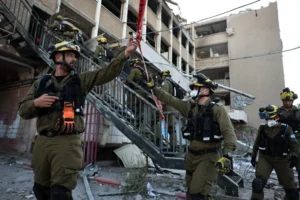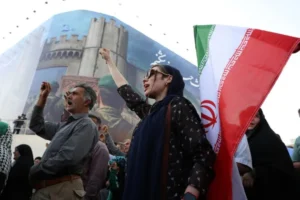
The Middle East stands at a dangerous crossroads as tensions between Iran and Israel have escalated into direct warfare. What began as regional hostility has now drawn in global superpowers, sparked missile attacks across borders, and triggered mass evacuations. This article provides the latest news, a timeline of events, and insights into the current status of the Iran-Israel conflict as of June 24, 2025.
🔥 What Triggered the Iran-Israel Conflict?
The roots of this war trace back to long-standing tensions over Iran’s nuclear program and its support for militant groups like Hezbollah and Hamas. In early June 2025, after intelligence reports confirmed that Iran resumed uranium enrichment at an alarming rate, Israel launched a pre-emptive airstrike on suspected nuclear facilities.
Iran retaliated with missile strikes on Israeli military bases and major cities like Ashdod and Beersheba. As the situation spiraled, the United States entered the conflict, launching “Operation Midnight Hammer” against Iran’s key nuclear infrastructure.
🕊️ Ceasefire Announced – But Is It Holding?
On June 23, a U.S.-brokered ceasefire was declared with a phased de-escalation plan:
-
Iran was to halt missile strikes by midnight (ET)
-
Israel would pause airstrikes by 12:00 PM (ET) on June 24
However, within hours of the ceasefire declaration, Iran launched a new wave of missiles targeting Israel and U.S. bases in Qatar, especially Al Udeid Air Base. While no U.S. casualties were reported thanks to prior warnings, Israel’s Defense Minister Israel Katz announced resumed airstrikes on Tehran, stating, “Israel will not tolerate deception.”

🧨 Key Military Developments
✅ Operation Midnight Hammer – U.S. Offensive
-
The U.S. bombed Fordow, Natanz, and Isfahan nuclear sites using B-2 bombers and Tomahawk cruise missiles
-
Iranian air defense was unable to intercept the full scale of the assault
-
President Trump (back in office) called it a “perfect and precision strike to halt nuclear madness”
🚀 Iranian Missile Counterstrikes
-
Iran used Kheybar Shekan and Fattah-2 hypersonic missiles
-
Targeted: Israeli cities (Beersheba, Ashdod) and U.S. military assets in the Gulf
-
A missile struck Soroka Medical Center in Beersheba, killing 5 civilians and injuring over 30
💣 Israeli Airstrikes and Iron Dome Response
-
Israeli Air Force targeted IRGC sites in Tehran, Shiraz, and Qom
-
Iron Dome successfully intercepted 90% of incoming missiles
-
A new “Iron Beam” laser defense system was reportedly tested and proved effective
🌍 Global Reactions & Concerns
🇷🇺 Russia Warns of “Nuclear Catastrophe”
-
The Kremlin issued a stern warning, calling U.S. strikes a “Pandora’s box”
-
Russian Foreign Minister claimed the situation could “push the world toward nuclear escalation”
🛢️ Oil Prices Surge and Fall
-
Brent crude spiked to $105/barrel but dipped after ceasefire hopes
-
Gulf shipping lanes, especially the Strait of Hormuz, remain under threat
-
Iran has threatened to close the Strait, which handles 30% of global oil shipments
✈️ Evacuations & Humanitarian Crisis
-
Over 9,000 Israelis and 3,000 Iranians have fled combat zones
-
Ireland, India, and Germany are evacuating citizens from Tehran and Tel Aviv
-
U.N. is calling for urgent peace talks and humanitarian access
📅 Timeline of Key Events
| Date | Event |
|---|---|
| June 17 | Israel launches airstrikes on Iranian nuclear sites |
| June 18 | Iran retaliates with missiles on Israeli cities |
| June 21 | U.S. launches “Operation Midnight Hammer” targeting Iran |
| June 22 | Iranian missiles hit U.S. base in Qatar and Beersheba Hospital |
| June 23 | Ceasefire announced by U.S. President |
| June 24 | Ceasefire breaks down amid renewed attacks |
🧭 What’s Next?
Will the War Expand?
With Hezbollah in Lebanon and militias in Syria mobilizing, there’s a risk of regional escalation. U.S. and Israeli intelligence are monitoring movements in:
-
Southern Lebanon (Hezbollah buildup)
-
Iraq and Syria (Iran-backed militia activity)

Will There Be More U.S. Involvement?
President Trump’s administration has hinted at a “Phase 2” operation if Iran continues attacking. Pentagon sources suggest possible cyber warfare and more drone strikes.
Will Iran Escalate with Nuclear Threats?
While the IAEA confirms damage to enrichment facilities, Iran still holds the capability to restart uranium production. There are fears of a possible “last-resort nuclear signal” if Tehran feels boxed in.
🧠 Expert Opinions
“This is no longer just a border conflict—it’s a test of the post-World War II global order,”
— Dr. Rami Shakib, Middle East Policy Analyst
“The next 48 hours are critical. If ceasefire fails completely, we may see the region spiral into chaos,”
— Gen. Mark Denton, U.S. Military Advisor (Ret.)
📌 Conclusion
The Iran-Israel war is no longer a regional conflict—it’s become a global flashpoint involving nuclear concerns, economic shocks, and humanitarian dangers. With the ceasefire hanging by a thread, the coming days will determine whether diplomacy can prevail or if the Middle East will descend further into war.
Stay tuned for real-time updates and verified developments on this rapidly unfolding situation.





